Saturday Sunrise
_______________________________________________________
"SOLAR WIND STREAM APPROACHES EARTH"
"A hole in the sun's atmosphere is spewing solar wind toward Earth. This image from NASA's Solar Dynamics Observatory shows where solar magnetic fields have parted, allowing the gaseous material to escape. Traveling faster than 600 km/s (1.3 million mph), the solar wind is expected to reach our planet on Sept. 24th, bringing a 40% chance of polar geomagnetic storms according to NOAA forecasters. The chance of storms rises to 50% on the next day, Sept. 25th, as Earth moves deeper into the stream. Northern sky watchers should be alert for autumn auroras."
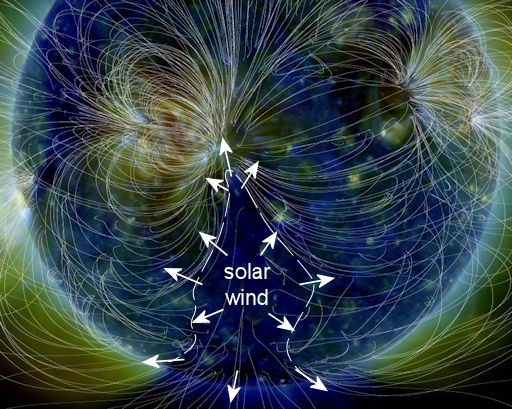
Northern Lights Forecast for Sunday, September 24th
"Forecast: Auroral activity will be high. Weather permitting, highly active auroral displays will be visible overhead from Inuvik, Yellowknife, Rankin and Iqaluit to Juneau, Edmonton, Winnipeg, Thunder Bay and Sept-Iles, and visible low on the horizon from Seattle, Des Moines, Chicago, Cleveland, Boston, and Halifax."
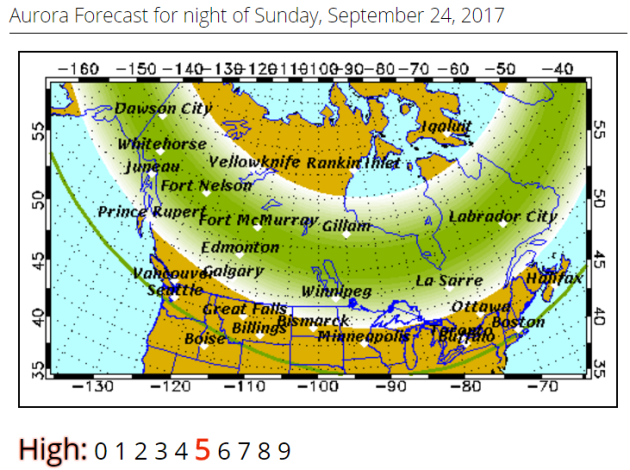
"Minnesota Crop Progress & Condition"
"Eighty-six percent of the corn for grain crop reached the dent stage, remaining 5 days behind the 5-year average. Thirteen percent had reached maturity, 10 days behind both last year and average. Corn for silage was 30 percent complete, 11 days behind average. Corn condition was 81 percent good to excellent. Eighty-one percent of the soybean crop was turning color with 36 percent dropping leaves. Scattered reports of soybean harvesting were noted in northern Minnesota. Soybean condition remained at 72 percent good to excellent. Nearly all of the dry edible bean crop was dropping leaves. One-quarter of the dry edible crop was harvested during the week, making the total harvest progress 44 percent complete. Dry edible bean condition rating was 66 percent good to excellent. Sunflower condition remained at 86 percent good to excellent. Potato harvest was 48 percent complete. Potato crop condition remained at 92 percent good to excellent. Sugarbeets were 8 percent lifted. Sugarbeet condition was unchanged at 89 percent good to excellent. The third cutting of alfalfa hay was 87 percent complete. Pasture condition declined to 54 percent good to excellent."
__________________________________________________________________
Minnesota Drought Conditions
According to the US Drought Monitor, only 0.05% of the state is considered to be in a SEVERE drought, which dropped from the near 2% last week. Also note that nearly 16% of the state is considered to be in a MODERATE drought, which is also down from the near 21% frmo last week.

_________________________________________________________________________
Tracking MARIA
According to the US Drought Monitor, only 0.05% of the state is considered to be in a SEVERE drought, which dropped from the near 2% last week. Also note that nearly 16% of the state is considered to be in a MODERATE drought, which is also down from the near 21% frmo last week.

_________________________________________________________________________
Tracking MARIA
We're still tracking MARIA in the Atlantic basin and according to NOAA's NHC, it was\ still a major category 3 storm with sustained winds of 115mph as of midday Saturday.
.gif)
Here's the official track from NOAA's NHC, which show the storm generally lifting north-northeast through the week ahead, but note the "cone of uncertainty" fanning out over the next several days. This means that there is still some uncertainty on where MARIA will actually track and could actually be a little closer to the East Coast, which would mean bigger impacts in those areas.
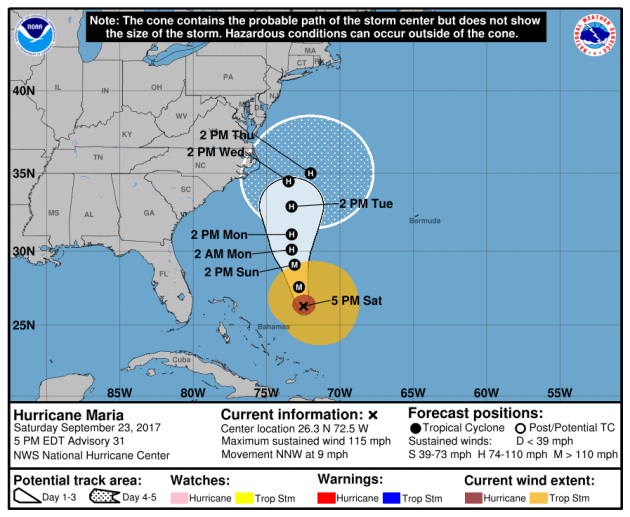
Tracking MARIA - GFS (American Model)
Here's the GFS (American Model) of MARIA as it nears the East Coast through the early week time frame. This particular model doesn't keeps the center of the storm off the East Coast, but we will likely still have big impacts across the region and especially along the coast. Keep in mind that it is still too early to tell exactly where the storm will track, it will be important to keep an eye on weather forecasts over the next few days.
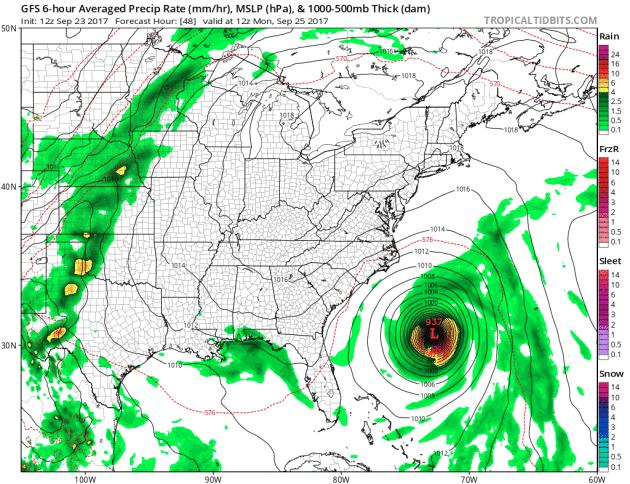
Tracking MARIA - ECMWF (European Model)
Just for comparison, here is the ECMWF model, which shows the placement of the storm at 1am Thursdday. While the center of the storm looks to stay offshore, we will likely still have strong winds, high surf and potentially heavy rains along the coast. Again, it's too early to tell where the storm will track exactly, but folks in these areas need to pay attention to weather forecast over the days ahead.
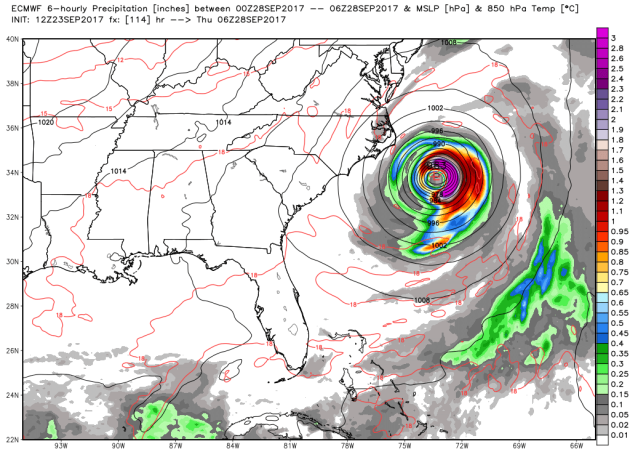
Here's a quick look at what kind of wind gusts we could be dealing with by 1AM Thursday. Note that some spots along the coast could be seeing up to 40mph+ wind gusts, while widespread tropical storm force (39mph+) wind gusts could be possible for a number of inland locations.
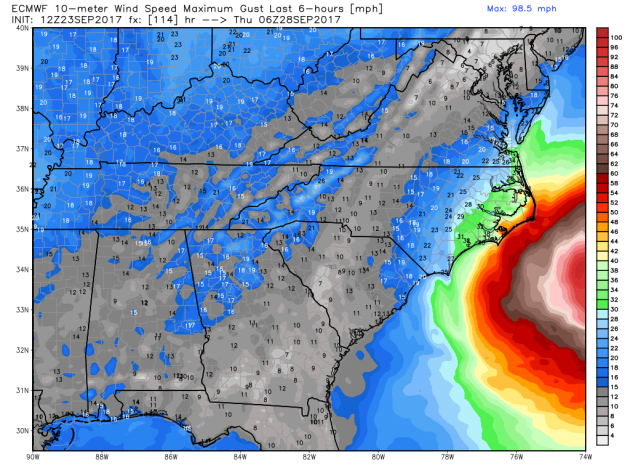
Tracking MARIA - How Much Rain?
Here's the rainfall potential through Thursday, which suggests fairly heavy rain in far eastern North Carolina. Note that some locations in the Outer Banks could see up to 2" to 4"+ rainfall. Again, keep in mind that the rain fall potential will be heavily dictated by the track of the storm. If the storm tracks farther west and closer to the coast, we can expect heavy rain & wind across a much wider area, but if the storm shifts east, we can expect less rain and not as strong of winds. Stay tuned...
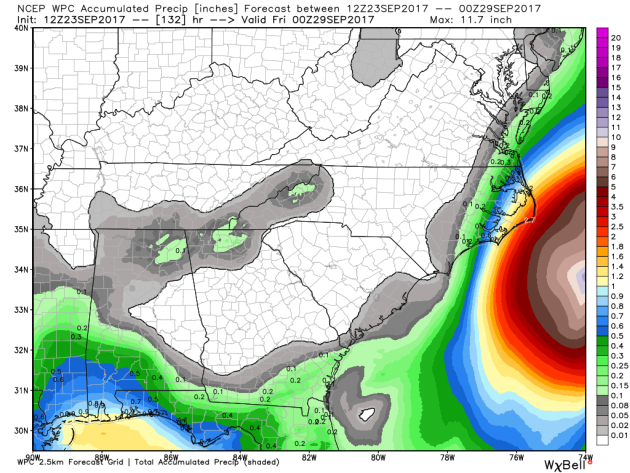
________________________________________________________
Atlantic Outlook Next 5 Days
Here's the Atlantic outlook over the next few days, which shows that the basin remains very active as we head into the 4th week of September. While LEE has once again redeveloped, it should cause any issues close to home, but we'll continue watching MARIA as it lifts north over the coming days.
.png)
Tracking LEE
Here's NOAA's NHC forecast for LEE, which at this point doesn't appear to be all that impressive as it tracks northwest over open water into early next week. Stay tuned...
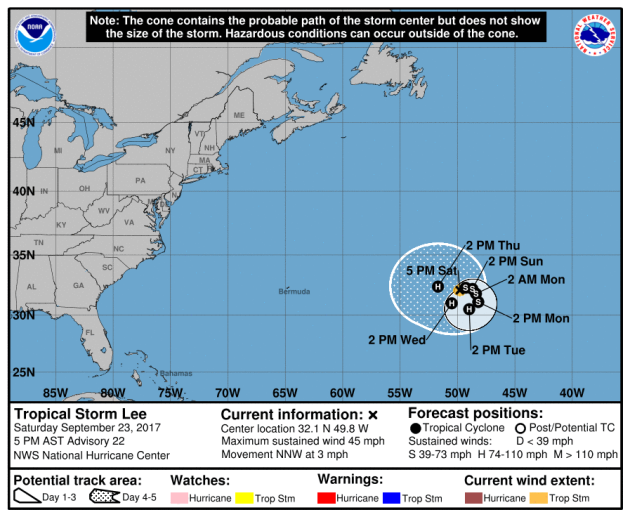
Active in the Eastern Pacific
While things remain active in the Atlantic Basin, things in the Eastern Pacific are still somewhat active. According to NOAA's NHC, tropical depression EIGHTEEN has formed and there is also another wave of energy that has a MEDIUM chance of tropical formation over the next 5 days.
.png)
___________________________________________________________
September 10th - Official Peak of the Atlantic Hurricane Season
It's only fitting that on the official peak of the Atlantic Hurricane Season (September 10th), Hurricane IRMA made landfall with the Lower Florida Keys at 9:10am on Sunday, September 10th. Note that the season, on average, remains pretty active through the rest of September and throughout October, but falls dramatically into November. Keep in mind that the official end of the Atlantic Hurricane Season is November 30th.
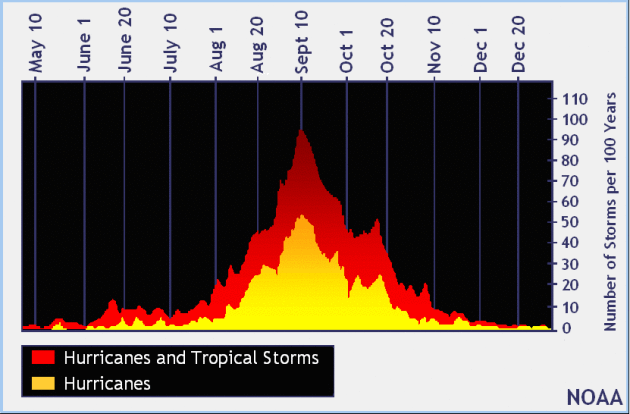
PRELIMINARY 2017 Tornado Map
It certainly has been a fairly active first half of 2017 with 1373 preliminary tornado reports through September 22nd. Note that this is the most tornadoes through September 22nd since 2011, when there were 1,784 reports. The map below shows the distribution of the tornadoes so far this year.
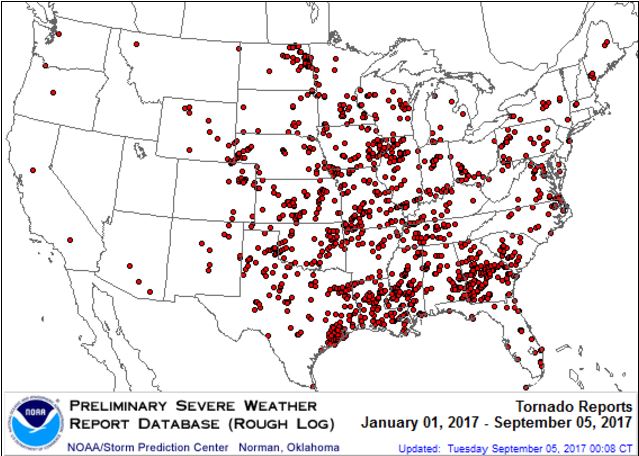 PRELIMINARY 2017 Tornado Count
PRELIMINARY 2017 Tornado Count
According to NOAA's SPC, the PRELIMINARY 2017 tornado count is 1373 (through September 22nd). Note that is the most active year for tornadoes since 2011, when there were 1,784 tornadoes. Keep in mind there was a major tornado outbreak in the Gulf Coast region from April 25-28, 2011 that spawned nearly 500 tornadoes, some of which were deadly. That outbreak is known as the Super Outbreak of 2011 and has gone down in history as one of the biggest, costliest and one of the deadliest tornado outbreaks in history.
.png)
_____________________________________________________________________
According to NOAA's SPC, the PRELIMINARY 2017 tornado count is 1373 (through September 22nd). Note that is the most active year for tornadoes since 2011, when there were 1,784 tornadoes. Keep in mind there was a major tornado outbreak in the Gulf Coast region from April 25-28, 2011 that spawned nearly 500 tornadoes, some of which were deadly. That outbreak is known as the Super Outbreak of 2011 and has gone down in history as one of the biggest, costliest and one of the deadliest tornado outbreaks in history.
.png)
_____________________________________________________________________
2.) Heavy rain across portions of the Southern Plains, Tue-Fri, Sep 26-Sep 29.
3.) High significant wave heights for coastal portions of the Mid-Atlantic and the Northeast, Wed, Sep 27.
4.) Heavy rain across portions of the Alaska Panhandle, Tue-Wed, Sep 26-Sep 27.
5.) Much above normal temperatures across portions of the Northeast, the Central Appalachians, the Mid-Atlantic, the Upper Mississippi Valley, the Great Lakes, and the Ohio Valley, Tue-Wed, Sep 26-Sep 27.
6.) Flooding occurring or imminent across portions of the Southeast.
7.) Severe Drought across the Central Plains, the Northern Plains, Hawaii, the Northern Rockies, the Middle Mississippi Valley, California, the Upper Mississippi Valley, and the Southern Plains.
.png)
_________________________________________________________
"Rain and snow take aim at the Montana drought"
"The weather this summer has been downright unruly, but it's ready to make amends. After months of extreme drought and fire, the state is getting some much-needed rain and snow. "We ended up receiving a second round of precipitation, mainly in southwest and central Montana," Jim Brusda, lead meteorologist with the National Weather Service, said. "It's pretty welcome because of how dry it has been." Lewistown is reaping the most benefits from the weather system with .32 inches by Friday afternoon. The east side of the Big Snowies has already received nine inches of snow. The rainfall wasn't too excessive in Great Falls, where only .18 inches fell, while, approximately .14 inches fell in Helena by Friday afternoon. Other places were worse off, with just a trace, .01 inches, in Cut Bank and nothing in Havre. But every drop of rain is going to good use. Brusda said the soil is absorbing all of the precipitation."
See more from Great Falls Tribune HERE:

Latest Drought Monitor


Exceptional and Extreme drought conditions are in place over parts of Montana and North and South Dakota due to several weeks/months of hot and dry weather. The image below suggests how much rain would be needed to end the drought, which suggests nearly 6" to 12" or more!
____________________________________________________________________
Chetco Bar Fire - 5 Miles Northeast of Brookings, OR
The Chetco Bar Fire near Brookings, Oregon is a very large wildfire in the Western US that started on Wednesday, July 12th by lightning and has grown to more than 191,000 acres! There are nearly 1,200 people working on this fire, which is 97% contained. The estimated containment date is set for Sunday, October 15th.
"Incident Summary: In the past week firefighters have made good progress in containing and strengthening lines around the Chetco Bar Fire. Firefighters, including crews with Oregon Army National Guard Task Force 5, continue to monitor and patrol the fireline, adding waterbars and recovering equipment where where containment objectives have been achieved. The current weather pattern is more favorable for firefighters and the area forecast includes more than an inch of rain in addition to cooler temperatures and higher humidity over the next few days. Evacuations and Closures: All Evacuation Advisories in Curry County and Josephine County have been lifted."
See more from Inciweb HERE:
(Credit: Andy Lyon)

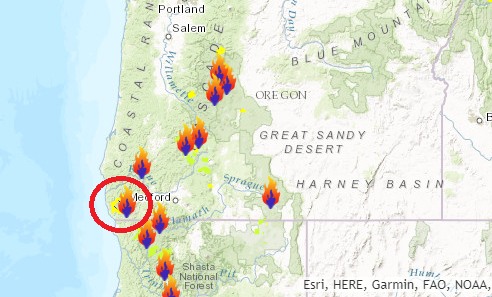 Diamond Creek Fire - Mazama, Washington
Diamond Creek Fire - Mazama, Washington
The Diamond Creek Fire near Mazama, Washington is a very large wildfire in the Western US that started on Sunday, July 23rd and has grown to more than 127,000 acres! There are nearly 227 people working on this fire, which is 75% contained. The estimated containment date is set for Sunday, October 15th.
"Incident Summary: The Diamond Creek Fire was reported on July 23, 2017 at approximately 9:45 a.m. The fire is burning in the Pasayten Wilderness and Eightmile drainage about 11 miles north of Mazama, Washington. Smokejumpers responded to the fire within two hours of it being reported. However, due to extreme terrain, heavy dead and down timber, and critical fire weather conditions, the fire was unable to be contained during initial response. The fire crossed into Canada on August 29. Fire managers recognized that the Diamond Creek Fire would likely be a long term event. Monitor, confine and point protection strategies are being used inside the Pasayten Wilderness. Outside the wilderness, the fire is being managed under a suppression strategy using a mixture of direct, indirect and point protection tactics when and where there is a high probability of success. Fire personnel will engage the fire at the appropriate time and location, while keeping public and firefighter safety as the top priority. Fire personnel are currently focused on identifying and implementing suppression repair work on the primary and contingency control lines. The suppression repair will not compromise the intended purpose of the control lines should they be needed at a later date"
See more from Inciweb HERE:
(Night time picture of a glowing yurt Credit: Brent Tannehill)

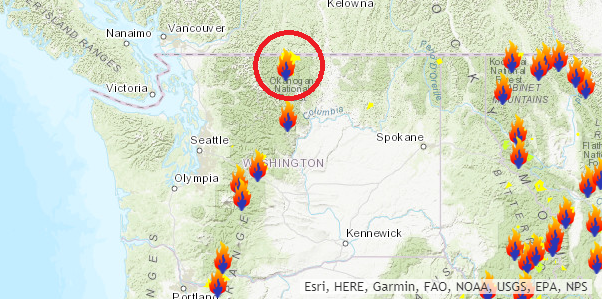 Ongoing Large Wildfires
Ongoing Large Wildfires
Here's a look at the current wildfire map across the country. Continued hot and dry weather has helped to spark several wildfires across the Western US. There have even been fires popping up in the Eastern U.S., two of the larger fires are burning in Florida.
Here's a list of all the current large wildfires from Inciweb:

The Chetco Bar Fire near Brookings, Oregon is a very large wildfire in the Western US that started on Wednesday, July 12th by lightning and has grown to more than 191,000 acres! There are nearly 1,200 people working on this fire, which is 97% contained. The estimated containment date is set for Sunday, October 15th.
"Incident Summary: In the past week firefighters have made good progress in containing and strengthening lines around the Chetco Bar Fire. Firefighters, including crews with Oregon Army National Guard Task Force 5, continue to monitor and patrol the fireline, adding waterbars and recovering equipment where where containment objectives have been achieved. The current weather pattern is more favorable for firefighters and the area forecast includes more than an inch of rain in addition to cooler temperatures and higher humidity over the next few days. Evacuations and Closures: All Evacuation Advisories in Curry County and Josephine County have been lifted."
See more from Inciweb HERE:
(Credit: Andy Lyon)
 Diamond Creek Fire - Mazama, Washington
Diamond Creek Fire - Mazama, WashingtonThe Diamond Creek Fire near Mazama, Washington is a very large wildfire in the Western US that started on Sunday, July 23rd and has grown to more than 127,000 acres! There are nearly 227 people working on this fire, which is 75% contained. The estimated containment date is set for Sunday, October 15th.
"Incident Summary: The Diamond Creek Fire was reported on July 23, 2017 at approximately 9:45 a.m. The fire is burning in the Pasayten Wilderness and Eightmile drainage about 11 miles north of Mazama, Washington. Smokejumpers responded to the fire within two hours of it being reported. However, due to extreme terrain, heavy dead and down timber, and critical fire weather conditions, the fire was unable to be contained during initial response. The fire crossed into Canada on August 29. Fire managers recognized that the Diamond Creek Fire would likely be a long term event. Monitor, confine and point protection strategies are being used inside the Pasayten Wilderness. Outside the wilderness, the fire is being managed under a suppression strategy using a mixture of direct, indirect and point protection tactics when and where there is a high probability of success. Fire personnel will engage the fire at the appropriate time and location, while keeping public and firefighter safety as the top priority. Fire personnel are currently focused on identifying and implementing suppression repair work on the primary and contingency control lines. The suppression repair will not compromise the intended purpose of the control lines should they be needed at a later date"
See more from Inciweb HERE:
(Night time picture of a glowing yurt Credit: Brent Tannehill)

Here's a look at the current wildfire map across the country. Continued hot and dry weather has helped to spark several wildfires across the Western US. There have even been fires popping up in the Eastern U.S., two of the larger fires are burning in Florida.
Here's a list of all the current large wildfires from Inciweb:
_________________________________________________________________________
National Weather Outlook
Here's the weather outlook through the early part of the week, which shows a cool front stalling across the central part of the country. This will keep the threat of scattered showers and storms ni place with areas of locally heavy rain. Also note MARIA, the tropical system in the Atlantic approaching the East Coast as we head into the early week time frame. This will bring heavy rain, wind and storm surge to places there.
.gif)
5 Day Precipitation Outlook
According to NOAA's WPC, the next several days could produce very heavy rainfall across the Plains with some 4" to 8" amounts possible, especially across parts of western Texas. Also note the heavy rain potential just clipping the East Coast, which would be associated with MARIA.
.gif)
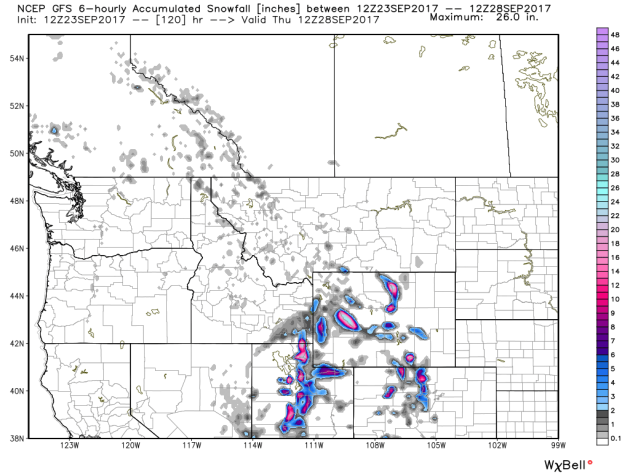
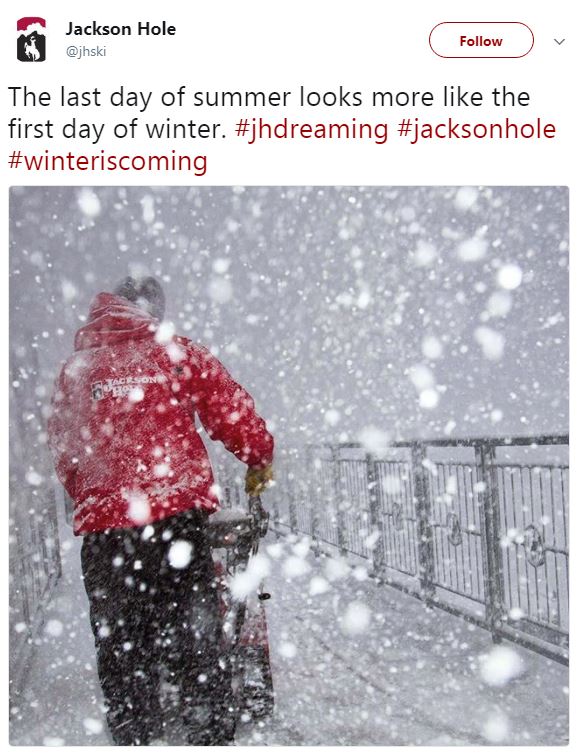
.gif)
Snowfall Potential
The next system that moves into the Pacific Northwest will bring another round of moisture and cold air, which will turn over to snow in the higher elevations. Here's the snowfall potential through Wednesday night, which shows up to 6"+ snowfall potential in the mountains... And so it begins!

________________________________________________________________________
Autumn Heat - Meteorological Black Swan Events
By Paul Douglas
By Paul Douglas
Maybe we've always had head-scratching, jaw-dropping weather. Perhaps it's social media; all of us plugged into The Matrix and more weather-aware. Or maybe it's a symptom of a larger disruption to our climate system. Not every day or ever week, but more moments where you see something on the news or weather map, and mumble "haven't seen THAT before."
Like a heat index of 101F on the first day of autumn in the Twin Cities. It could be snowing right now - instead we're taking turns whining about a drippy, debilitating dew point.
Nederland, Texas reported 64.6 inches of rain from Hurricane Harvey, a new record for wettest tropical cyclone. Off-the-scale-wet. Hurricane Maria brushes the Outer Banks Wednesday before turning out to sea. We may go through the entire alphabet this year, just like 2005.
The mercury approaches 90F later Sunday before a sluggish front arrives with heavy showers & T-storms Sunday night and Monday, with close to an inch of rain. Daytime highs hold in the 60s this week; nights dipping into the 40s. This freakish July weather-rewind will give way to jackets soon.
________________________________________________________________________
Extended Forecast
SUNDAY: Hot sun. Storms tonight: Winds: S 10-15. High: 88.
SUNDAY NIGHT: Chance of storms. Winds: S 5-10. Low: 67
MONDAY: Heavy showers and storms. Winds: SW 7-12. High: 72.
TUESDAY: Showers taper. Drying out PM hours. Winds: NW 8-13. High: 66.
WEDNESDAY: More sun, comfortably cool. Winds: NW 7-12. Wake-up: 49. High: 66.
THURSDAY: Clouds increase. Lukewarm breeze. Winds: NW 5-10. Wake-up: 52. High: 70.
FRIDAY: Reinforcing clipper, few showers. Winds: N 10-15. Wake-up: 50. High: 59.
SATURDAY: Blue sky. Fresh air transfusion. Winds: N 7-12. Wake-up: 45. High: 62.
_______________________________________________________
This Day in Weather History
September 24th
September 24th
1985: 0.4 inches of snow falls in the Minneapolis area.
1982: Tropical air moves north into Minnesota. The Twin Cities have a low of 71.
1869: Heavy rain dumps nearly 10 inches on the White Earth Reservation.
________________________________________________________
________________________________________________________
Average High/Low for Minneapolis
September 14th
September 14th
Average High: 68F (Record: 89F set in 1935)
Average Low: 49F (Record: 30F set in 1942)
Average Low: 49F (Record: 30F set in 1942)
Record Rainfall: 1.06" set in 1934
Record Snowfall: 0.4" set in 1985
_________________________________________________________
Record Snowfall: 0.4" set in 1985
_________________________________________________________
Sunrise/Sunset Times for Minneapolis
September 24th
September 24th
Sunrise: 7:03am
Sunset: 7:06pm
Sunset: 7:06pm
Hours of Daylight: 12hours & 3mins
Daylight LOST since yesterday: ~3 minutes and 6 seconds
Daylight LOST since summer solstice (June 20th): 3 hours & 34 minutes
__________________________________________________________
Daylight LOST since summer solstice (June 20th): 3 hours & 34 minutes
__________________________________________________________
Moon Phase for September 24th at Midnight
2.8 Days Before First Quarter
2.8 Days Before First Quarter

_________________________
Weather Outlook For Sunday
Temperatures on Sunday will still be quite warm across the region with temps running nearly 15F to 20F above average ahead of the front. However, behind the front it is nearly 15F to 25F cooler than average. Dewpoints will also remain quite sticky ahead of the front with some spots nearing 70F again. However, highs along and west of the front will only be in the 40s and 50s!

Weather Outlook For Sunday
Winds will be out of the south on Monday ahead of the front, which will help to keep the heat and humidity in place, while winds will switch to the north-northwest west of the front, which will help to bring much cooler temps to those areas.
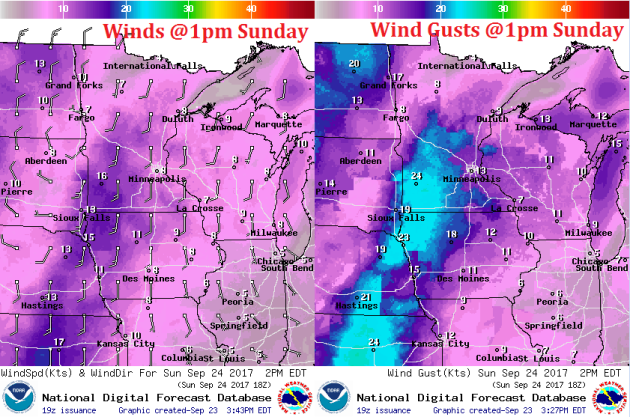
A stalled frontal boundary will continue to keep showers and storms in place across the eastern Dakotas and far western MN once again on Sunday. Ahead of the front, sultry sunshine will continue just like it did on Friday and Saturday.

__________________________________________________________________________
Simulated Radar Ahead...
Here's the simulated radar across the Upper Midwest as we head from late weekend into early next week. The stalled front will slowly move east through the early week time period, which will help to bring areas of storms and heavy rain to parts of the region.
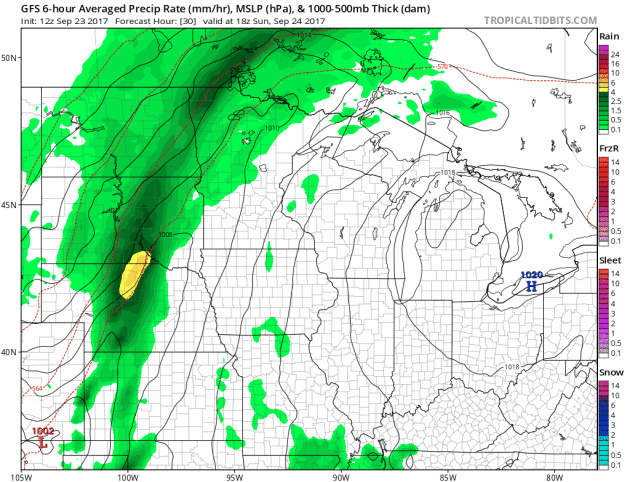
Rainfall Potential Ahead
Here's the rainfall potential across the state as we head through Thursday. Note that many areas across western and northern Minnesota could stay quite wet with some widespread 1" to 2"+ tallies.
.png)
______________________________________________________
Pollen Forecast
Itchy, sneezy? I tend to get a little more allergic as we head through September until the first frosts of the season start to arrive. With that said, according to pollen.com, the allergy forecast for Minneapolis suggests low to low-medium levels over the next few days thanks to several rain chances this week. AHHH-CHOOO!!!
Minneapolis Temperature Outlook
Here's the temperature outlook through October 8th, which shows temps staying very warm on Sunday, but will cool significantly by midweek with highs only in the 60s. The extended forecast calls for more fall-like temps then through the rest of the month into the early part of October Note that the average high in the Twin Cities on September 30th is 65F with an average overnight low of 46F.
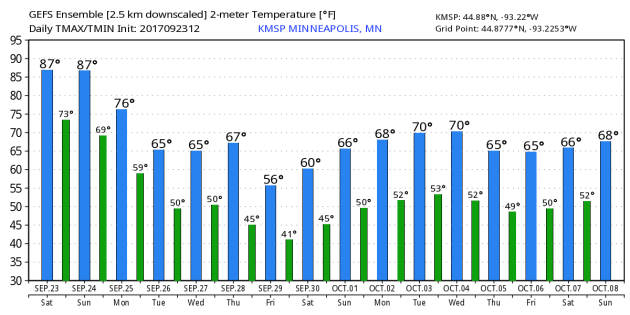
6 to 14 Day Temperature Outlook
According to NOAA's CPC, the extended temperature outlook from October 2nd through the 6th suggests warmer than average temperatures possible across parts of the Midwest.
___________________________________________________________
Extended Temperature Outlook
According to NOAA's CPC, the extended temperature outlook through October 8th shows that a good chunk of the Southern U.S. will be cooler than average, but the Western and Northern US will remain warmer than average.
Fall Color - Coming To A Tree Near You...
It's about that time of the year again to gaze upon Mother Nature's fall foliage, which is really starting to show up. By now, you've probably noticed a few eager trees changing color pretty rapidly, some of this could be due to a little stress, but it's not uncommon to start seeing some changes at this time of the year.
Minnesota Fall Color Update
According the MN DNR, much of the state is already starting to see hints of fall color, however, there are pockets of 50%-75% color across northern Minnesota!
Typical Fall Color Peak in Minnesota
Here are the typical fall color peak times across the state of Minnesota and note that areas along the northern tier of the state usually see their peak toward the 2nd half of September. However, peak color usually doesn't arrive in central Minnesota until October, but we're getting close.
Typical Fall Color Times Across the Country
Here are the typical fall color peak times across the country, which suggests that much of the peak across the northern half of the nation usually wraps up through the month of October.
__________________________________________________________
 _______________________________________________________________
_______________________________________________________________
"Irma may speed the end of orange juice"
"The most recent estimates of the widespread damage to Florida’s orange trees put the statewide losses as high as 70 percent. Hurricane Irma plundered Florida’s orange belt, leaving a trail of uprooted trees, downed fruit and flooded groves worse than anything growers say they have seen in more than 20 years. It could even be the knock-out blow for a product — orange juice — that has been slipping in popularity among Americans, although the beverage still ranks as the country’s favorite fruit. The most recent estimates of the widespread damage to Florida’s orange trees put the statewide losses as high as 70 percent. That could lead to orange shortages, price hikes and, for farmers, lost harvests — all on top of a debilitating plant disease called citrus greening and a long-term national decline in orange juice consumption. “Significant is not the right word,”said Shannon Shepp, the executive director of the growers’ group Florida Department of Citrus, describing the damage to Florida’s orange juice industry. “It’s somewhere between significant and catastrophic. And that’s a big word — I don’t use it lightly.” It could have implications not only for Florida agriculture, but for the American diet."
See more from DenverPost HERE:
(Fruit sits on the ground below an orange tree at the Alico Inc. Lake Patrick Grove in Frostproof, Florida, on Sept. 11, 2017. Daniel Acker, Bloomberg via DenverPost)
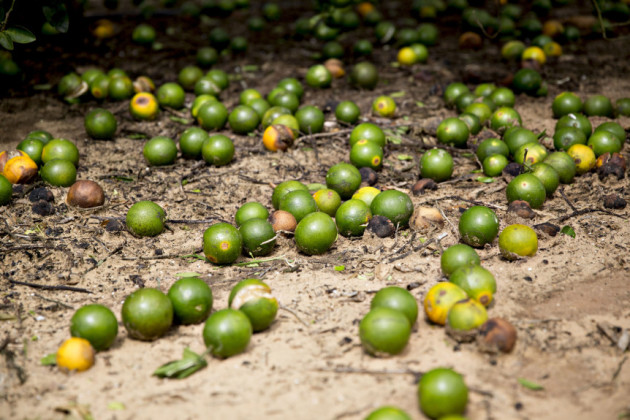
_________________________________________________________________"California cities want Big Oil to pay for costs of climate change"
"Coastal cities in California that are vulnerable to flooding caused by climate change are fighting back against Big Oil. San Francisco and Oakland filed lawsuits this week demanding that ExxonMobil, Chevron (CVX), BP, ConocoPhillips (COP) and Royal Dutch Shell pay billions to cover the costs of sea walls and other protections against rising sea levels. The aggressive strategy from the Bay Area makes San Francisco and Oakland the first major U.S. cities to attempt to shift the costs of climate change from the public to fossil fuel companies. San Francisco and Oakland fear that billions of dollars of property in low-lying areas will be swamped by rising sea levels that scientists blame on climate change. "These fossil fuel companies profited handsomely for decades while knowing they were putting the fate of our cities at risk," San Francisco City Attorney Dennis Herrera said in a statement announcing the lawsuits, which were filed in Superior Court in San Francisco and Alameda Counties."
See more from CNN HERE:
(Image credit: Getty images via CNN.com)
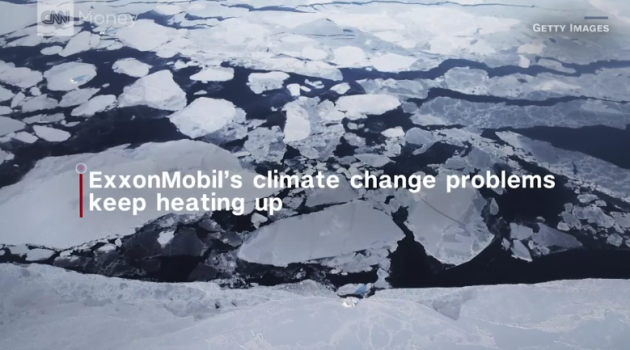
______________________________________________________________"One of the most bizarre ideas about climate change just found more evidence in its favor"
"More and more, we are learning that climate change can lead to some pretty strange and counterintuitive effects, especially when it comes to the wintertime. For instance, scientists have pointed out for a number of years that warmer seas, and a wetter atmosphere, can actually fuel more snowfall in massive nor’easters affecting the U.S. East Coast. More controversial still is an idea called “Warm Arctic, Cold Continents.” This is the notion that as the Arctic warms up faster than the middle latitudes, it may sometimes cause a displacement of the region’s still quite frigid air to places that aren’t so used to it. In other words, even as the planet warms, masses of cold air could also become more mobile and deliver quite a shock at times when outbreaks occur in more southerly latitudes."
See more from Washington Post HERE:
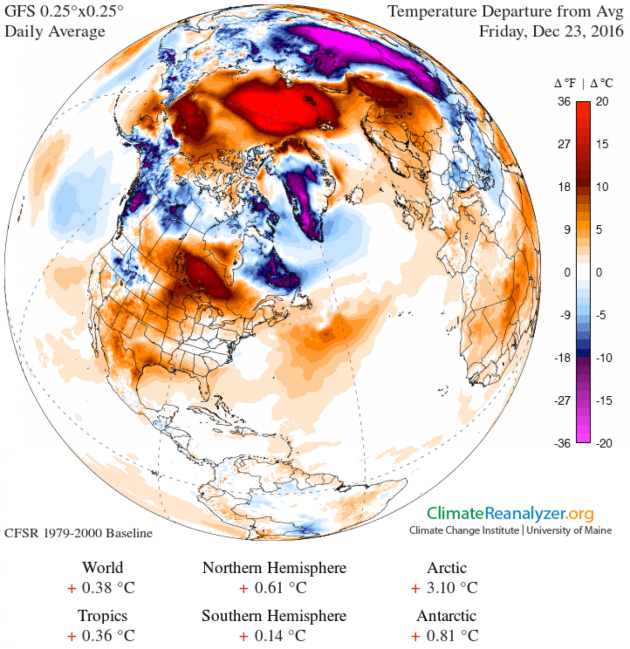
_________________________________________________________________"NASA’S OSIRIS-REx Spacecraft Slingshots Past Earth"
"NASA’s asteroid sample return spacecraft successfully used Earth’s gravity on Friday to slingshot itself on a path toward the asteroid Bennu, for a rendezvous next August. At 12:52 p.m. EDT on Sept. 22, the OSIRIS-REx (Origins, Spectral Interpretation, Resource Identification, and Security – Regolith Explorer) spacecraft came within 10,711 miles (17,237 km) of Antarctica, just south of Cape Horn, Chile, before following a route north over the Pacific Ocean. OSIRIS-REx launched from Cape Canaveral Air Force Station in Florida on Sept. 8, 2016, on an Atlas V 411 rocket. Although the rocket provided the spacecraft with the all the momentum required to propel it forward to Bennu, OSIRIS-REx needed an extra boost from the Earth’s gravity to change its orbital plane. Bennu’s orbit around the Sun is tilted six degrees from Earth’s orbit, and this maneuver changed the spacecraft’s direction to put it on the path toward Bennu. As a result of the flyby, the velocity change to the spacecraft was 8,451 miles per hour (3.778 kilometers per second)."
See more from NASA Here:
(OSIRIS-REx is NASA's mission to explore near-earth asteroid Bennu, collect a sample, and return it to Earth. To get to Bennu, however, OSIRIS-REx must first leave the plane of Earth's orbit and match the orbital tilt of its target. On September 22, 2017, OSIRIS-REx approached Earth and flew over its southern hemisphere, passing within 11,000 miles of Antarctica. Credits: NASA's Goddard Space Flight Center)
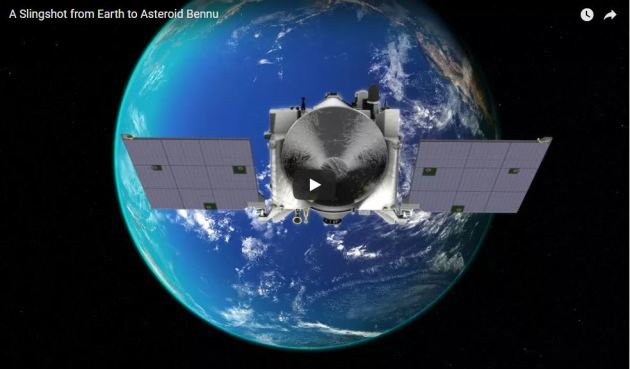
_________________________________________________________________
See more from DenverPost HERE:
(Fruit sits on the ground below an orange tree at the Alico Inc. Lake Patrick Grove in Frostproof, Florida, on Sept. 11, 2017. Daniel Acker, Bloomberg via DenverPost)

_________________________________________________________________"California cities want Big Oil to pay for costs of climate change"
"Coastal cities in California that are vulnerable to flooding caused by climate change are fighting back against Big Oil. San Francisco and Oakland filed lawsuits this week demanding that ExxonMobil, Chevron (CVX), BP, ConocoPhillips (COP) and Royal Dutch Shell pay billions to cover the costs of sea walls and other protections against rising sea levels. The aggressive strategy from the Bay Area makes San Francisco and Oakland the first major U.S. cities to attempt to shift the costs of climate change from the public to fossil fuel companies. San Francisco and Oakland fear that billions of dollars of property in low-lying areas will be swamped by rising sea levels that scientists blame on climate change. "These fossil fuel companies profited handsomely for decades while knowing they were putting the fate of our cities at risk," San Francisco City Attorney Dennis Herrera said in a statement announcing the lawsuits, which were filed in Superior Court in San Francisco and Alameda Counties."
See more from CNN HERE:
(Image credit: Getty images via CNN.com)

______________________________________________________________"One of the most bizarre ideas about climate change just found more evidence in its favor"
"More and more, we are learning that climate change can lead to some pretty strange and counterintuitive effects, especially when it comes to the wintertime. For instance, scientists have pointed out for a number of years that warmer seas, and a wetter atmosphere, can actually fuel more snowfall in massive nor’easters affecting the U.S. East Coast. More controversial still is an idea called “Warm Arctic, Cold Continents.” This is the notion that as the Arctic warms up faster than the middle latitudes, it may sometimes cause a displacement of the region’s still quite frigid air to places that aren’t so used to it. In other words, even as the planet warms, masses of cold air could also become more mobile and deliver quite a shock at times when outbreaks occur in more southerly latitudes."
See more from Washington Post HERE:

_________________________________________________________________"NASA’S OSIRIS-REx Spacecraft Slingshots Past Earth"
"NASA’s asteroid sample return spacecraft successfully used Earth’s gravity on Friday to slingshot itself on a path toward the asteroid Bennu, for a rendezvous next August. At 12:52 p.m. EDT on Sept. 22, the OSIRIS-REx (Origins, Spectral Interpretation, Resource Identification, and Security – Regolith Explorer) spacecraft came within 10,711 miles (17,237 km) of Antarctica, just south of Cape Horn, Chile, before following a route north over the Pacific Ocean. OSIRIS-REx launched from Cape Canaveral Air Force Station in Florida on Sept. 8, 2016, on an Atlas V 411 rocket. Although the rocket provided the spacecraft with the all the momentum required to propel it forward to Bennu, OSIRIS-REx needed an extra boost from the Earth’s gravity to change its orbital plane. Bennu’s orbit around the Sun is tilted six degrees from Earth’s orbit, and this maneuver changed the spacecraft’s direction to put it on the path toward Bennu. As a result of the flyby, the velocity change to the spacecraft was 8,451 miles per hour (3.778 kilometers per second)."
See more from NASA Here:
(OSIRIS-REx is NASA's mission to explore near-earth asteroid Bennu, collect a sample, and return it to Earth. To get to Bennu, however, OSIRIS-REx must first leave the plane of Earth's orbit and match the orbital tilt of its target. On September 22, 2017, OSIRIS-REx approached Earth and flew over its southern hemisphere, passing within 11,000 miles of Antarctica. Credits: NASA's Goddard Space Flight Center)
_________________________________________________________________
Thanks for checking in and don't forget to follow me on Twitter @TNelsonWX

No comments:
Post a Comment